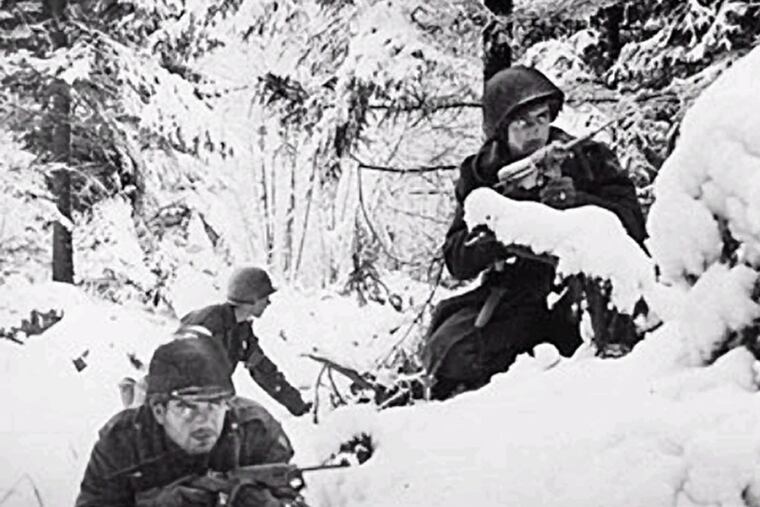A cousin I never met died 75 years ago in the Battle of the Bulge, but my family has kept his memory alive | Perspective
Staff Sgt. Bart Shea of Oaklyn, N.J., was killed Jan. 15, 1945, near Malmedy, Belgium, one of 19,000 Americans to die during the German offensive.

He died almost 10 years before I was born, but my cousin Bart F. Shea was a presence in my life. Movie-star good-looking in his Army uniform, his photo was a constant reminder that he fell fighting in World War II, an event that dominated the imaginations of so many boys my age.
I did not know until I was an adult that he died in the final days of the Battle of the Bulge, that 40-day slog through ice and mud that proved to be a decisive-but-bloody turning point in the war against Nazi Germany.
With the 75th anniversary of his death upon us, Bart has returned to my thoughts and reminded me of the sacrifice of so many young men and women like him who were taken from their families to fight in a cause a nation thought was worthy of their lives.
Looking at his picture now, it is hard to imagine many men who could be more handsome: his black hair combed back, his high cheekbones and almost mischievous but inviting smile. He was the son of my Great-Aunt Ray, sister of my maternal grandmother, Jane Laggy. His father, Bart J. Shea, is said to have inherited a small fortune, but drank much of it away.
My grandmother was one of seven Sherrer sisters from Gloucester City, of whom Ray was the oldest. During the Depression and the war, they often shared homes, bringing three or four of them and their families together under one roof. Cousins and siblings were one and the same. To my mother, Patricia, who was 14 when Bart died, he was her champion, the one who wanted her to go to college and paid her to shine his saddle shoes because no one else could do it better.
After the war, when the sisters settled in their own houses, one could not go into any of their homes and not see that picture of Bart in his uniform. Reverence attached to his name to me and the offspring of the band of sisters who rode out hard times, the war, some drunken husbands, and loss together.
The photo of Bart was the only one of a deceased person to be displayed in my house until John F. Kennedy was assassinated in 1963, the same year Aunt Ray died.
Before the war, Bart had attended Collingswood High School; worked in the offices at United Engineers & Constructors, a major Philadelphia builder; and had married “out of the church." He and his wife, the former Eileen Dymond, lived in Oaklyn when Bart entered the Army at Fort Dix less than two months after Pearl Harbor. They had been married less than a year.
Bart served at bases around the country and rose to the rank of staff sergeant after attending noncommissioned officers training school. In February 1944, two years after entering the Army, he shipped out to Britain as a member of Company G, 120th Infantry Regiment, 30th Infantry Division. The division landed on Omaha Beach five days after the D-Day invasion. Another cousin, Leo Sherrer, had landed on D-Day and was already engaged in combat inland.
On July 17, Bart was wounded by a landmine during the Battle of St. Lô and sent back to England. After recovering, he rejoined his unit in November and was wounded again, but not seriously enough to be hospitalized.
The 30th Division was getting some needed R&R when the Battle of the Bulge began and returned to the front to confront the First SS Panzer Division. The 30th had fought the First before, holding back the division during a Nazi counterattack in France in the heat of August. In Belgium, they had to endure biting cold and snow and granite skies that grounded air power that could have helped break the stalemate earlier.
On Jan. 14, 1945, close to Malmedy, Belgium, the 30th Division found the bodies of 82 American POWs that German forces had massacred the day after the battle started.
I do not know if Bart was involved in the Malmedy discovery. What I do know is that on Jan. 15, he was shot and killed in action there. He was 27, two years younger than my own son is now and one of 19,000 Americans to lose their lives in the drawn-out battle. He sent his last letter home from Belgium.
There was some fear that Bart, recipient of the Purple Heart with Oak Leaf Cluster, would not be allowed to receive a Catholic funeral because he had married outside the church. But as my mother tells it, a priest ruled that he would because he had made the ultimate sacrifice. Two Masses were said for him: one in February 1945 and the second in December 1947 after Aunt Ray fought to have his remains returned to the United States.
My mother says that after the war a soldier from Bart’s unit visited Aunt Ray and told her Bart had been wounded in a skirmish and had told his men to help others who were wounded instead of him or to seek cover. “Too many have died saving my life already,” he supposedly said. Clearly, there is no way to ascertain the veracity of this account, but it gave Aunt Ray a measure of consolation.
Bart is buried with his parents in a plot at St. Mary’s Cemetery in Bellmawr. If he had survived the war, I am sure he would have been a living presence in my life. I have a cousin and a brother who bear his name. We’ll keep his memory alive for a while more.